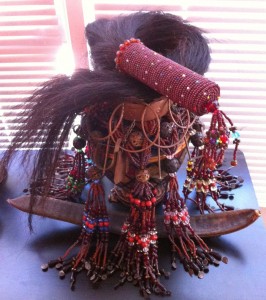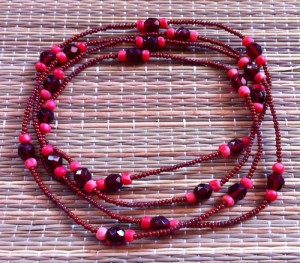
Oyá is the orisha of the marketplace, the winds, and change. She is the owner of the gates of the cemetery and a ferocious female warrior.
- Oyá (also Ollá, Yansa or Yansán) is a fierce and powerful female warrior orisha in Santeria. She is the owner of the marketplace, and keeps the gates of the cemetery. She is the force of change in nature and in life. She wields lightning and rides the winds into battle, often fighting with her machetes side-by-side with her favorite lover, Changó. Oyá raises the armies of the dead as her soldiers and is said to use the tornado as her weapon. Oyá’s aché is fierce, tumultuous, changing and protective.
- Contrary to what many assume, Oyá does not live in the cemetery. She lives in the marketplace and steers the changing fortunes made through business. She does own the cemetery gates and will escort the spirits of the dead to the threshold of the graveyard, but it is actually Obba and Yewá who live in the cemetery itself. Oyá is said to control the air and winds in nature, and often rides storms into battle against her enemies.
- Oya is a complex orisha who has endured much sadness in her life. She is known as the “mother of nine” for she gave birth to nine different stillborn children. She carries much sadness about her incapacity to give birth and she dresses with nine different colored scarves around her waist in memory of her lost children. When Oshún ejected her twins, the Ibeji, out of her house it was Oyá who took in the Ibeji and raised them as her own. (Some lineages say it was Yemaya who raised the Ibeji.)
- Oyá has a close relationship with several orishas including Oshun, Ogun and Changó. In the odu Oshe Meji (5-5), Oshun’s life was fading away due to mankind’s preoccupation with life issues, and negligence of her worship. It was Oya who insisted that Chango divine with the diloggún for the first time to mark ebó (sacrifice) to save Oshun’s life; forever bonding the two in friendship. Oyá was once married to Ogun, and it was he who forged her favorite weapon – the machete. Oyá left Ogun and became one of Chango’s lovers. It was only Oyá who could truly keep Chango in his place. She stole Chango’s secret of throwing lightning, and knew how to use Chango’s fear of the dead to keep him under control.
There is also a great misunderstanding about the relationship between Oyá and Yemaya. These two orishas do not have enmity between them. This is a misunderstanding perpetuated by author Migene Gonzalez-Whippler that Yemaya supposedly tricked Oya into exchanging the sea for the cemetery. This pataki is not found anywhere in odu – it is a folk tale not based in our religion and originates from a lack of understanding in ceremony.
There is actually a ceremonial reason why Oya and Yemaya (Chango, and Inle too, for that matter) cannot be in the same room when Oya is being consecrated. This story is captured in the diloggún odu Ogbe’sa (8-9). Oya was betrayed by the ram. It was once her best friend and then tried to betray her to collect the bounty that was out on Oya’s head. When his treason was uncovered, Olofi demanded that the ram be killed. Oya cannot stand the sight of the ram because of his betrayal, but at the same time she cannot bear to see him being killed because she still cares for him. Ram is the favorite food of Chango and Yemaya (and Inle too). These orishas bear the scent of ram. So when Chango or Yemaya (or Inle) are being consecrated, Oya’s items must be out of the sacred room (Igbodú). Similarly if Oya is being consecrated, Chango and Yemaya (or Inle) cannot be anywhere near her items. This is strictly because of the ram’s betrayal and has nothing to do with personal issues.
Not all Olorishas receive Oyá at their kariocha initiation. Children of Chango, Yemaya and Inle do not receive this orisha when they are being crowned, but they can receive her at a later time if divination marks it as necessary.
Symbols, Numbers, Colors and Attributes of Oyá

An eleke for Oyá is typically distinguished by the use of a special brown bead with thin white and black stripes. This eleke utilizes coral and burgundy crystals.
Number: 9
Sacred Place in Nature: the marketplace, wind and the gates of the cemetery
Colors: brown or burgundy, plus nine different colors (no black)
Tools: machetes, masks, scythe, horsetail fly-whisk (iruke)
Temperament: fierce, temperamental, protective
Syncretized Catholic Saint: Our Lady of Candlemas or Saint Theresa
Oyá’s Caminos (Avatars or “Roads”)
Oya is singular in nature and as such has no roads or “caminos”.
Offerings for Oyá
Oyá enjoys sweet and dark colored foods. Her addimus and offerings include plums, eggplants, red wine, chocolate pudding, black she goat, black hens, pigeons and guinea hen.
Chocolate pudding for Oyá
A delicious cooked addimú you can make for Oyá is chocolate pudding. While many people will simply grab a box of instant chocolate pudding from the store, it is an extra act of love to make this from scratch for this powerful and lovely orisha. You’ll need 1 cup of sugar, 1/2 cup of baking cocoa, 1/4 cup of cornstarch, 1/2 teaspoon of sal, 4 cups of milk (you can use goats milk to make it more special for Oyá), 2 tablespoons of butter, and 2 teaspoons of vanilla extract. In a heavy saucepan, mix the sugar, cocoa, cornstarch and salt together. Slowly add the milk while stirring and bring the mixture to a boil over medium heat. Boil for two minutes then remove from the heat and add the butter and vanilla. Stir until well blended and pour into a glass serving dish. Chill in the refrigerator until firm. Serve by placing Oyá’s vessel on a grass mat and placing the dish next to her. You can garnish the pudding with nine ladyfinger cookies or 9 wafer cookies. After the proper amount of time has elapsed, remove the pudding and dispose of it at a corner of an outdoor marketplace or at the gates of a cemetery as marked by divination.
Eggplants for Oyá
A great addimú for Oyá that doesn’t require any cooking is eggplant. Oya loves eggplants. You’ll need a basket large enough to hold 9 eggplants for this. Line the basket with a lovely wine-colored cloth (it can be decorated with multi-color flowers) and place all 9 eggplants inside of it. Set this before Oya’s shrine and pray for your desired needs. After the right amount of time has elapsed, wrap up the eggplants in the cloth along with 9 pennies and take them to an outdoor marketplace. Dispose of the ebó preferably in a trash can near the entrance to the market to avoid littering with a prayer of thanks for Oyá.You can keep the basket and reuse it for future offerings.

 Pagan Blog Project
Pagan Blog Project
Follow Us!